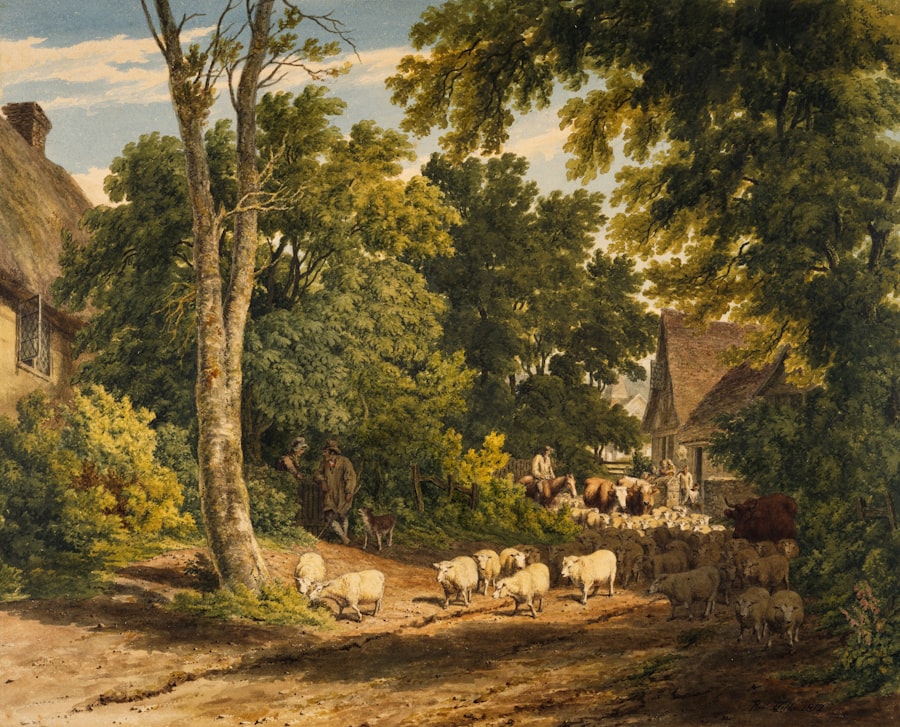Neo-Expressionism emerged in the late 1970s and early 1980s as a reaction against the minimalism and conceptual art that dominated the art world at that time. The movement revived the expressive and emotive qualities of art, drawing inspiration from the German Expressionist movement of the early 20th century. Neo-Expressionism sought to reintroduce raw emotion, bold colours, and gestural brushwork that had been largely absent from the art world for several decades.
The movement was also a response to the political and social climate of the era, with artists using their work to address issues such as consumerism, urban decay, and the human condition. Neo-Expressionism was characterised by its rejection of formalism and its embrace of a more intuitive and spontaneous approach to art-making. The movement quickly gained popularity in Europe and the United States, with artists such as Jean-Michel Basquiat, Julian Schnabel, and Anselm Kiefer at the forefront.
The origins of Neo-Expressionism can also be traced back to the punk and graffiti movements of the 1970s, which rejected traditional artistic conventions and embraced a DIY ethos. This rebellious spirit was reflected in the work of Neo-Expressionist artists, who often used unconventional materials and techniques to create their art. The movement was also influenced by the rise of postmodernism, which challenged the idea of a single, universal truth and encouraged artists to explore multiple perspectives and narratives.
Neo-Expressionism rejected the cool, detached aesthetic of minimalism and conceptual art, and returned to the emotional and personal aspects of art-making. The movement was characterised by its bold, confrontational imagery and its rejection of traditional artistic boundaries, embracing a wide range of styles and influences. Neo-Expressionism celebrated individuality and self-expression, paving the way for a new generation of artists to explore their own unique voices.
Summary
- Neo-Expressionism emerged in the late 1970s as a reaction against minimalism and conceptual art, drawing inspiration from German Expressionism and Abstract Expressionism.
- Key characteristics of Neo-Expressionism include bold, gestural brushwork, intense colours, and a focus on emotional and psychological themes.
- Influential artists of the Neo-Expressionist movement include Jean-Michel Basquiat, Julian Schnabel, and Anselm Kiefer, who gained international recognition for their powerful and provocative works.
- Neo-Expressionism has had a significant impact on various art forms, including painting, sculpture, and printmaking, with artists exploring new ways to convey raw emotion and personal expression.
- The legacy of Neo-Expressionism can be seen in the continued emphasis on individual expression and the rejection of formal constraints in contemporary art, influencing artists across the globe.
Key Characteristics of Neo-Expressionism
Rejection of Conceptual Art
This emphasis on process and materiality was a direct response to the conceptual art of the 1960s, which had prioritised ideas and concepts over the physical act of making art. Neo-Expressionist artists sought to reconnect with the physicality of art-making, using their work as a means of expressing their innermost thoughts and emotions.
Figurative Imagery and Themes
Another key characteristic of Neo-Expressionism is its use of figurative imagery to explore themes of identity, alienation, and the human condition. Many Neo-Expressionist artists drew inspiration from popular culture, incorporating elements of graffiti, comic books, and street art into their work. This fusion of high and low culture was a deliberate rejection of the elitism of the art world, and a celebration of the diversity and complexity of contemporary society.
Symbolism and Social Commentary
The movement was also characterised by its use of symbolism and allegory to address political and social issues, with artists using their work to critique consumerism, war, and environmental degradation. Overall, Neo-Expressionism was a celebration of individuality and self-expression, embracing a wide range of styles and influences to create a rich tapestry of artistic expression.
Influential Artists of the Neo-Expressionist Movement

The Neo-Expressionist movement produced a number of influential artists whose work continues to have a lasting impact on contemporary art. One such artist is Jean-Michel Basquiat, whose raw, graffiti-inspired paintings captured the energy and vitality of New York City in the 1980s. Basquiat’s work often featured bold, gestural brushwork and fragmented figures, reflecting his interest in African-American history, popular culture, and social justice issues.
Another key figure in the Neo-Expressionist movement is Julian Schnabel, whose large-scale paintings combined elements of abstraction and figuration to create powerful, emotionally charged works. Schnabel’s use of unconventional materials such as broken plates and tarpaulins added a tactile quality to his work, blurring the boundaries between painting and sculpture. Anselm Kiefer is another influential artist associated with Neo-Expressionism, known for his monumental paintings that explore themes of memory, history, and mythology.
Kiefer’s work often incorporates symbolic imagery such as sunflowers, barbed wire, and lead, creating a sense of weight and gravitas that reflects his interest in existential questions. The German artist also used his work to confront Germany’s troubled past, addressing issues such as the Holocaust and the legacy of World War
Neo-Expressionism in Different Art Forms
Neo-Expressionism was not limited to painting but also extended its influence to other art forms such as sculpture, photography, and printmaking. In sculpture, artists such as David Smith and Louise Bourgeois embraced the raw energy and emotional intensity of Neo-Expressionism, creating dynamic works that challenged traditional notions of form and materiality. Smith’s welded steel sculptures were characterised by their bold, gestural forms and dynamic compositions, while Bourgeois’ use of organic materials such as wood and fabric added a tactile quality to her emotionally charged works.
In photography, artists such as Cindy Sherman and Nan Goldin used the medium to explore themes of identity, gender, and sexuality, drawing inspiration from the raw emotional intensity of Neo-Expressionist painting. Sherman’s iconic self-portraits challenged traditional notions of femininity and beauty, while Goldin’s intimate snapshots captured the gritty reality of urban life in New York City in the 1980s. In printmaking, artists such as Kiki Smith and Elizabeth Murray embraced the bold colours and gestural forms of Neo-Expressionism, creating dynamic works that pushed the boundaries of traditional printmaking techniques.
Overall, Neo-Expressionism had a profound impact on a wide range of artistic practices, inspiring artists across different mediums to embrace a more intuitive and spontaneous approach to art-making. The movement’s emphasis on raw emotion, bold colours, and gestural brushwork continues to influence contemporary artists working in diverse fields, from painting and sculpture to photography and printmaking.
The Impact of Neo-Expressionism on Contemporary Art
The Influence on Painting
Contemporary painters such as Cecily Brown and Dana Schutz draw inspiration from the raw energy and emotional intensity of Neo-Expressionist painting, creating works that challenge traditional notions of form and composition. Brown’s dynamic compositions are characterised by their bold brushwork and vibrant colours, while Schutz’s emotionally charged figures reflect her interest in exploring themes of identity, alienation, and the human condition.
The Impact on Sculpture
In sculpture, artists such as Kiki Smith and Anish Kapoor continue to push the boundaries of form and materiality, drawing inspiration from the raw energy and emotional intensity of Neo-Expressionist sculpture. Smith’s use of organic materials such as glass and wax adds a tactile quality to her emotionally charged works, while Kapoor’s monumental sculptures challenge traditional notions of space and scale.
The Legacy in Photography and Beyond
In photography, artists such as Wolfgang Tillmans and Nan Goldin continue to explore themes of identity, gender, and sexuality, drawing inspiration from the raw emotional intensity of Neo-Expressionist photography. Overall, Neo-Expressionism has had a profound impact on contemporary art, inspiring artists across different mediums to embrace a more intuitive and spontaneous approach to art-making. The movement’s emphasis on raw emotion, bold colours, and gestural brushwork continues to shape the work of artists working in diverse fields, from painting and sculpture to photography and printmaking.
Criticisms and Controversies Surrounding Neo-Expressionism

Despite its widespread popularity, Neo-Expressionism has not been without its criticisms and controversies. Some critics have argued that the movement’s emphasis on raw emotion and gestural brushwork comes at the expense of formal innovation and conceptual depth. They have accused Neo-Expressionist artists of prioritising style over substance, creating works that are emotionally charged but lack intellectual rigor.
Others have criticised the movement for its embrace of figurative imagery at a time when abstraction was gaining prominence in the art world. There have also been controversies surrounding issues of cultural appropriation within the movement, with some critics accusing Neo-Expressionist artists of exploiting marginalized cultures for their own gain. This criticism has been particularly directed at white male artists who have drawn inspiration from African-American culture without acknowledging or addressing issues of race and privilege in their work.
Overall, while Neo-Expressionism has been celebrated for its bold energy and emotional intensity, it has also faced criticisms for its perceived lack of formal innovation and its potential for cultural insensitivity.
The Legacy of Neo-Expressionism
The legacy of Neo-Expressionism continues to be felt in contemporary art, with its emphasis on raw emotion, bold colours, and gestural brushwork continuing to influence artists across different mediums. The movement’s rejection of formalism in favour of a more intuitive approach to art-making has paved the way for new generations of artists to explore their own unique voices and perspectives. Contemporary painters such as Cecily Brown and Dana Schutz continue to draw inspiration from the raw energy and emotional intensity of Neo-Expressionist painting, creating works that challenge traditional notions of form and composition.
In sculpture, artists such as Kiki Smith and Anish Kapoor continue to push the boundaries of form and materiality, drawing inspiration from the raw energy and emotional intensity of Neo-Expressionist sculpture. Smith’s use of organic materials such as glass and wax adds a tactile quality to her emotionally charged works, while Kapoor’s monumental sculptures challenge traditional notions of space and scale. In photography, artists such as Wolfgang Tillmans and Nan Goldin continue to explore themes of identity, gender, and sexuality, drawing inspiration from the raw emotional intensity of Neo-Expressionist photography.
Overall, Neo-Expressionism has left an indelible mark on contemporary art, inspiring artists across different mediums to embrace a more intuitive approach to art-making. The movement’s emphasis on raw emotion, bold colours, and gestural brushwork continues to shape the work of artists working in diverse fields, from painting and sculpture to photography and printmaking.
If you are interested in learning more about the evolution of art movements, you may want to check out an article on Thinkofart.com that provides an introduction to Prehistoric Art. This article explores the origins of art and the earliest forms of expression, shedding light on the foundations of artistic expression that have influenced movements such as Neo-Expressionism. You can read the article here.
FAQs
What is Neo-Expressionism?
Neo-Expressionism is an art movement that emerged in the late 20th century, particularly in the 1970s and 1980s. It is characterized by a return to expressive, emotive and often raw forms of artistic expression, drawing on the styles of earlier Expressionist movements.
What are the key characteristics of Neo-Expressionist art?
Neo-Expressionist art is known for its bold use of colour, gestural brushwork, and a focus on conveying emotion and personal experience. The subject matter often includes themes of urban life, political commentary, and personal identity.
Who were some prominent Neo-Expressionist artists?
Some of the most well-known Neo-Expressionist artists include Jean-Michel Basquiat, Julian Schnabel, Anselm Kiefer, and Georg Baselitz. These artists gained international recognition for their bold and expressive works.
How did Neo-Expressionism differ from earlier Expressionist movements?
While Neo-Expressionism drew inspiration from earlier Expressionist movements, it differed in its embrace of contemporary subject matter and a more direct engagement with popular culture and mass media. Additionally, Neo-Expressionist artists often rejected the formal constraints of traditional artistic techniques.
What impact did Neo-Expressionism have on the art world?
Neo-Expressionism had a significant impact on the art world, particularly in the 1980s. It revitalized interest in painting as a medium and brought attention to the personal and emotional aspects of artistic expression. The movement also influenced other art forms, such as music and fashion.




